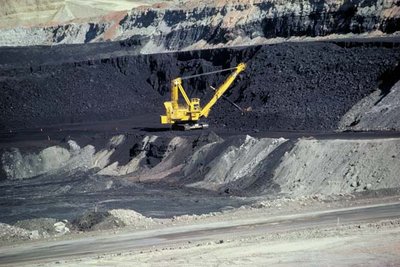Coal mining
|
|

The most economical method of coal extraction from coal seams depends on the depth and quality of the seams, and also the geology and environmental factors of the area being mined.
If the coal seams are near the surface, the coal is extracted by either:
- strip mining, in which coal is exposed by the advancement of an open pit or strip. As the coal is exposed and extracted the overburden from the still covered coal fills the former pit, and strip progresses.
Most open cast mines in the USA extract bituminous coal. In South Wales opencasting for steam coal and anthracite is practised.
However most coal seams are too deep underground for open cast mining. Most coal is extracted by either:
- bord and pillar, Here mining progresses along the seam, pillars are left to support the roof. These pillars may be removed on retreat allowing the roof to cave in. This method of mining is used principally in the U.S.A.
- longwall mining, Here mining is conducted along the seam with the use of self-advancing hydraulic roof supports known as "chocks" or "shields". These supports are placed in a line (up to 400 metres long), known as a "longwall" and as coal is removed from in front of the longwall, the supports are advanced. As the longwall advances, the cavity created behind the longwall known as "the goaf" caves in. Longwall mining is the principle method of underground mining in Australia.
Other methods of mining include continuous highwall mining and highwall auger mining. These methods are generally applied in an open cast mine, once open cut mining becomes uneconomic.
Coal mining historically, has been a very dangerous activity. Open cut hazards are principally slope failure, underground mining roof collapse and gas explosions. Most of these risks can be greatly reduced in modern mines, and multiple fatality incidents are now rare in the developed world. Improvements in mining methods ie. longwall mining, gas drainage and ventilation have reduced many of these risks. In lesser developed countries, thousands still die in coal mines. China in particular is the world leader in coal mining related deaths, with official estimates of around 6000 fatalities in 2004. Unofficial estimates place the figure much higher, at around 20,000 deaths. China is also the world leader in coal production and consumption.
Chronic lung diseases, such as pneumoconiosis are common to miners, causing a reduced life-expectancy for those in the occupation.
The industry has been subject to sometimes violent labor relations in the U.S. (for example, see Ludlow Massacre); union organizers were sometimes murdered by management.
Now coal mining is highly unionized, and the unions are sometimes militant. Mining communities are often close-knit with a strong sense of community spirit and religious faith. They also tend to be strongholds of left-wing political parties.
The oldest continuously worked deep-mine in Britain and possibly the world is Tower Colliery at the northern end of the south Wales valleys. This colliery was started in 1805 and at the end of the 20th century it was bought out by its miners rather than allow it to be closed.
Coal mining frequently causes significant adverse environmental impacts. Strip mining typically destroys most environmental value in the land through which it passes. All forms of mining are likely to generate areas where coal is stacked and where the coal has significant sulfur content, such coal heaps generate highly acidic metal rich drainage when exposed to normal rainfall. These liquors can cause severe environmental damage to receiving water-courses. In addition, the waste heaps are subject to slipping, as in the Aberfan disaster which killed 144 people in 1966.
The World Championships in coal-carrying take place every Easter Monday, at Ossett in West Yorkshire, U.K. The race starts from the site of the old Saville & Shaw Cross colliery.
